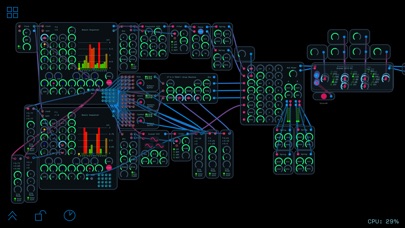

Then run your finger along the bottom of your iPhone/iPad (maybe on the side, as I think there is also a mic on the side of the new iPad Pro) and watch the audio level on the input jump high on the meter. Run your finger over the mic of your BT headphones and watch the audio input level not move at all or maybe just slightly. it will start the input while the loops are running. Then, while that is running, click the microphone at the top of the screen. You can then go to the audio loops section of the app, and start playing a loop or a few. Note the clarity you get compared with the audible input hum you hear when Audulus is running. You can verify this yourself by opening the Garage Band app while your headphones are paired. IOS knows when you have BT headphones attached (this is why you get the warning about latency when you open GB while wearing BT headset or connected to a BT speaker), and something in their API seems to flip a switch to bypass the microphone on your wireless headset ( I am certain that Apple is aware of the lower quality codec/dual-channel mono issue that results from using a microphone on a bluetooth headset), and the OS instead utilizes the microphone on the bottom of your device. The reason I mention foreground is because as soon as iOS backgrounds the app and Audulus is open, the default crappy 2-way audio profile returns. That will benefit you in many ways, as you can plug in headphones that way until this BT issue is fixed, and you will also have the ability to plug in a standard USB MIDI controller to your dock, which is really nice, NP man, happy to be of service! I spent a while messing with GarageBand after discovering what I mentioned, and a little more today to refresh my memory, and I was able to ascertain that, however GarageBand is written, the reason why you don’t see this issue is because there is a fundamental difference in the way that iOS treats BT headphones when GB is open and in the foreground.


If you only plan to work In iOS, then you should probably get a USB-C hub for your iPad. also mentioned reasons for this idea in a post not long ago. I build most of my patches on macOS and then use them on iOS later.
#Audulus bluetooth speaker Patch
It enables you to get a bigger view of what you’re working with, and you don’t have to keep zooming in to make connections and turn knobs etc while setting up and tuning, and zoom back out to get a better view of your patch as a whole. I have both and I feel very strongly that it is worth the investment. If you have the flow, I would absolutely recommend buying the desktop version, as well.
#Audulus bluetooth speaker mac
On Mac you can select the internal microphone as the selected input source, changing the codec to a higher quality, as well as disabling the undesired input audio feed. There is not an iOS workaround, as you cannot choose another ‘input’ (as you want none active, without specifically requesting it with the mic or the ADC node) that will not take in sound, thereby changing the codec and disabling the mic in use, unfortunately. You can view more info about my findings here. I just hadn’t noticed the input channel was actively passing audio before, as I live alone and my apartment is pretty quiet. I’m almost 100% sure the issue you’ve mentioned is related to something I tested and documented a while back.
#Audulus bluetooth speaker full
This means if you bring your speaker along and end up not using it, you can still treat it like a battery pack and squeeze out a full phone charge.I saw your post about this yesterday, and I tested a few things with my 3 BT headsets (AirPods, Skullcandy Hesh 2, Beats Solo 3 wireless) and got the same result as you with each. The Braven’s total battery capacity for example is only slightly less than the battery of an iPhone 5. The battery sharing feature is a handy feature to have on any speaker, even those with smaller battery packs. In the case of the Nyne’s beefy battery, for example, you could go to the beach and listen to music for around five hours (depleting the battery roughly 50 percent) and still have enough juice left over to use the speaker as a battery pack and fully charge your phone. RELATED: The Complete Guide to Buying an External Battery Pack Battery sharing allows you to plug a USB cable into your speaker just like you would plug a USB cable into a battery pack and, with the click of a button, supply juice to your mobile devices like phones and tablets. While this feature is largely absent from lower-end speakers, most mid-to-high-end speakers have it (both of our models do).


 0 kommentar(er)
0 kommentar(er)
